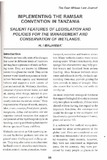| dc.description.abstract | Wetlands are basically units oflandscapes
that occur in different kinds of locations
andmay have a presence of static or flowing
water. They are known by different
names throughout the world. They are in
essence water-based ecosystems at the interface
between aquatic and terrestrial
habitats and support a wide variety of
plant and animal life. Wetlands, therefore,
comprise of places where water, soil and
air, among other things, interact to produce
wetland vegetation at a depth that
usually does not exceed six meters. 1 They
may comprise of areas of marsh, streams,
lakes, rivers, swamps, flood plains, ponds,
mangroves, deltas and estuaries and are
important natural resources that support
components of the hydrological cycle in
breeding, rearing and feeding habitats for
diverse species of fauna and flora.
Wetlands can serve as fish spawning areas
and herbivore pastures and also as
ground water discharge and recharge areas.
They may also serve as mechanisms
for flood control, shoreline stabilization,
erosion control, storm protection, watertransport,
recreation and tourism attraction.
Many wetlands contain water or can
soak up water. When it rains heavily, their
sponge-like characteristic may help protect
houses and farmland from serious
flooding. Also, because wetlands retain
water and release it slowly, the lands surrounding
them may provide grazing for
farm animals in times of drought. They
also ensure that boreholes and wells do
not dry up. | en_US |



